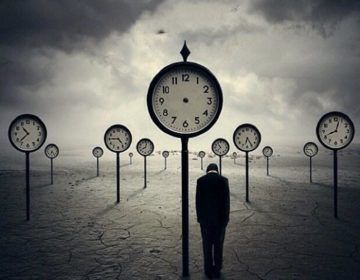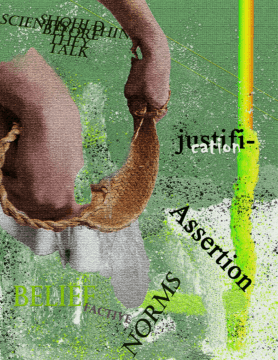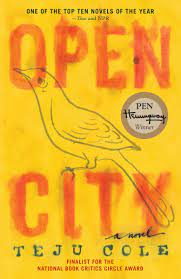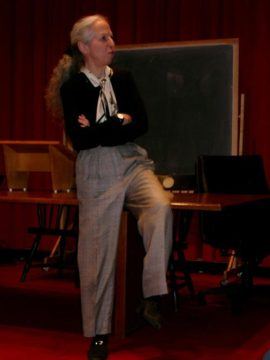by Brooks Riley

Though we are an aggregator blog (providing links to content elsewhere) on all other days, on Mondays we have only original writing by our editors and guest columnists. Each of us writes on any subject we wish, and the length of articles generally varies between 1000 and 2500 words. Our writers are free to express their own opinions and we do not censor them in any way. Sometimes we agree with them and sometimes we don’t.Below you will find links to all our past Monday columns, in alphabetical order by last name of the author. Within each columnist’s listing, the entries are mostly in reverse-chronological order (most recent first).
by Brooks Riley

by Mark Harvey

In the spring of 2018, Earl Cooper noticed that the wild horses roaming on the desert where he lived were suffering terribly from the ongoing drought in eastern Utah. The springs where they watered were drying up and there was very little grass with the lack of moisture. On his forays into the desert, he came across horses too weak to stand up and some that had already succumbed to starvation and thirst.
Cooper was a white man who had been living on the Navajo Nation near Monument Valley for about 25 years. From a young age, he had been obsessed with horses, and his home in the Utah desert afforded him endless opportunities to ride for miles and miles with distant horizons of vermilion cliffs and canyons.
On his rides, he could see the two rocky lobes that defined the Bears Ears 40 miles to the north and he could see Navajo Mountain, known to the tribe as Naatsisʼáán, 40 miles to the south. And there were the bands of wild horses roaming the country, sometimes curiously approaching Cooper and sometimes gliding away from him at a graceful lope over the rugged terrain.
Cooper had found companionship with horses nearly his entire life. “There’s a feeling you get with them,” he says. “It’s a camaraderie. Horses are our best friends and helped us pioneer the west.”
So that spring as he saw more and more horses where he lived suffering, he said to himself, “I gotta do something. If I don’t, no one will.” Read more »
by Mary Hrovat
 A rose is a rose is…well, you know. Botanically, a rose is the flower of a plant in the genus Rosa in the family Rosaceae. But roses carry the weight of so much symbolism that a rose is seldom only a rose.
A rose is a rose is…well, you know. Botanically, a rose is the flower of a plant in the genus Rosa in the family Rosaceae. But roses carry the weight of so much symbolism that a rose is seldom only a rose.
Their symbolic luster is so intense that it casts an alluring light not only on the word rose itself but also on many of the phrases that contain it. A song called “The Last Zinnia of Summer” could never be as melancholy as “The Last Rose of Summer,” no matter how much you like zinnias. When I was a child and a teenager, I read a lot of things that I only half-understood. One of these was the phrase attar of roses, which had a mysterious and lovely sound to me. I eventually learned that it’s an essential oil made using damask roses—a beautiful common name for Rosa damascene. I had a vague impression of damask as a luxurious silky or satiny fabric, so I thought damask roses must have especially soft satiny petals, but in fact the species name was given to them because they were thought by some to be native to Damascus. The fabric is also named for Damascus, which was once an important producer and trade center for damasks.
There’s also a glow in my mind around concepts that are less directly related to roses. Rose gold is an alloy of gold with copper and perhaps silver; the phrase is especially luminous to me and reminds me of sunrise. Ashes of roses—another term I ran across in my early reading, and one that delights me still—describes a soft dusty pink color. Read more »
you whos teh aiye
ait nus korook wahv rai
ais see chzut na sue kul
ais ma che sanaan uth bilqul
this year again they came
wavered warbled
where we thoughtlessly
felled that tree
—Translated from the original Kashmiri by Rafiq Kathwari
by Thomas O’Dwyer

1066 And All That, a sly rewrite of the history of England, was published in 1930 and became a perennial bestseller. Its subtitle was A Memorable History of England, Comprising All the Parts You Can Remember, Including 103 Good Things, 5 Bad Kings and 2 Genuine Dates. Written by W. C. Sellar and R. J. Yeatman, the book, in the words of one critic, “punctured the more bombastic claims of drum-and-trumpet narratives … both the Tory view of ‘great man’ history and the pieties of Liberal history.” There is no connection, literary or otherwise, between this satirical non-fiction and 2666, the weighty novel by Chilean author Roberto Bolaño, published after his death from liver failure in 2003 at the age of 50. However, that phrase “all the parts you can remember” triggered an association when I found a battered copy of Bolaño’s novel among some old books discarded on a park bench. But it was a half copy — the covers and last 100 pages of the 900-page tome were missing. “The parts you can remember” reminded me of my spotty knowledge of Latin American writing picked up in those faddy years following the so-called Boom in the region’s literature from the 1950s to the 1970s. In the English-reading world, any serious book-lover felt obliged to mention, at the drop of a dinner-party conversation, Jorge Luis Borges, Julio Cortázar, Gabriel García Márquez, Mario Vargas Llosa, Isabel Allende, Octavio Paz, or Carlos Fuentes. The ultimate one-upmanship would have been to claim reading one of the authors in Spanish, but in my years in England, I never heard anyone do so. “You don’t read Borges,” one friend mocked. “You read his translator. That’s like washing your feet with your socks on.” Read more »
by Mindy Clegg

Today punk is a relatively celebrated subculture. Amy Poehler recently directed Moxie, a film about teen girls influenced by the punk riot girl movement of the 1990s, using zines (a self-published magazine popular in punk circles) to combat misogyny at their school. The film includes an appearance from the Linda Lindas, an all-girl punk band from LA covering Bikini Kill’s “Rebel Girl.” Kathleen Hanna of Bikini Kill was recently interviewed with her partner Adam “Adrock” Horowitz of the Beastie Boys by none other than journalist Dan Rather. A recent Guardian article argued that pop punk is the “sound of 2021.” But mainstream culture was not always accepting of punk. During the 1980s, a “punk panic” emerged that positioned punk as a dire threat threat to public order. Punks were cast as nihilistic, destructive, and dangerous villains. Punk panic was found in the west and in the communist East. Two examples are in the US and in East Germany. In both cases, the authorities considered punks to be a danger to the social fabric, showing that during the Cold War, public order was considered critical in both the capitalist west and the communist east. Read more »
by Pranab Bardhan
All of the articles in this series can be found here.
 By the time I started regular school my father’s home-schooling had prepared me enough to sail through the various half-yearly and annual examinations relatively easily. Indian exams, certainly then and to a large extent even now, do not test your talent or learning ability, they are mainly a test of your memorizing capacity and dexterity in writing coherent answers in a frantic race against time. I found out that I was reasonably proficient in both, and that it is for the lack of proficiency in these two qualities some of my friends, whom I considered highly imaginative and creative, were not doing so well in school.
By the time I started regular school my father’s home-schooling had prepared me enough to sail through the various half-yearly and annual examinations relatively easily. Indian exams, certainly then and to a large extent even now, do not test your talent or learning ability, they are mainly a test of your memorizing capacity and dexterity in writing coherent answers in a frantic race against time. I found out that I was reasonably proficient in both, and that it is for the lack of proficiency in these two qualities some of my friends, whom I considered highly imaginative and creative, were not doing so well in school.
My father did not believe in ‘positive feedback’, would not praise me for doing quite well in the various exams in school (and later in university)—he used to tell my mother that overpraise may go to my head– instead, he’d ask me why the gap in my marks (those days marks were in absolute numbers) from the student who was ranked second has not increased compared to last time!
Looking back, I think this lack of positive feedback served one good purpose in my later life. It has helped me in trying not to overestimate myself in any capacity. Even when other people have gushed with praise for me on various occasions in my professional career, while that has been pleasant, it was for myself largely water off a duck’s back (in a symmetric way, facing attacks and criticisms has not usually dislodged my footing). I usually tell myself that I more or less know what I am worth, nothing more, nothing less. I think I am not prone to false modesty, but I remember what Churchill said, in his usual pompous haughty way, about Attlee: when someone praised Attlee as a modest man, Churchill reportedly said, “He has much to be modest about”. I know very well I have much to be modest about. Read more »
by George Barimah, Ina Gawel, David Stoellger, and Fabio Tollon*

When thinking about the claims made by scientists you would be forgiven for assuming that such claims ought to be true, justified, or at the very least believed by the scientists themselves. When scientists make assertions about the way they think the world is, we expect these assertions to be, on the balance of things, backed up by the local evidence in that field.
The general aim of scientific investigations is that we uncover the truth of the matter: in physics, this might involve discovering a new particle, or realizing that what we once thought was a particle is in fact a wave, for example. This process, however, is a collective one. Scientists are not lone wolves who isolate themselves from other researchers. Rather, they work in coordinated teams, which are embedded in institutions, which have a specific operative logic. Thus, when an individual scientist “puts forward” a claim, they are making this claim to a collection of scientists, those being other experts in their field. These are the kinds of assertions that Haixin Dang and Liam Kofi Bright deal with in a recent publication: what are the norms that govern inter-scientific claims (that is, claims between scientists). When scientists assert that they have made a discovery they are making a public avowal: these are “utterances made by scientists aimed at informing the wider scientific community of some results obtained”. The “rules of the game” when it comes to these public avowals (such as the process of peer-review) presuppose that there is indeed a fact of the matter concerning which kinds of claims are worthy of being brought to the collective attention of scientists. Some assertions are proper and others improper, and there are various norms within scientific discourse that help us make such a determination.
According to Dang and Bright we can distinguish three clusters of norms when it comes to norms of assertions more generally. First, we have factive norms, the most famous of which is the knowledge norm, which essentially holds that assertions are only proper if they are true. Second, we have justification norms, which focus on the reason-responsiveness of agents. That is, can the agent provide reasons for believing their assertion. Last, there are belief norms. Belief norms suggest that for an assertion to be proper it simply has to be the case that the speaker sincerely believes in their assertion. Each norm corresponds to one of the conditions introduced at the beginning of this article and it seems to naturally support the view that scientists should maintain at least one (if not all) of these norms when making assertions in their research papers. The purpose of Dang and Bright’s paper, however, is to show that each of these norms are inappropriate in the case of inter-scientific claims. Read more »
by Joseph Shieber

On June 15 of this year, the National Constitution Center hosted a session entitled, “Free Speech, Media, Truth and Lies”. The topic for the session, as described by the National Constitution Center website, was “Should the government or private companies identify and regulate truth and lies?” There were three speakers. Harvard Law School Professor (and former Dean) Martha Minow argued for the role of government regulation to reverse the tide of internet misinformation, the Cato Institute’s Paul Matzko argued against a government role (predictably; he’s at the Cato Institute), and Jonathan Rauch (of Brookings), author of the seemingly omnipresent recent book The Constitution of Knowledge: A Defense of Truth, landing somewhere in the middle. (There’s a nice write-up of the discussion by Rachel Reed at Harvard Law Today.)
Minnow sketched a number of remedies to address the problems plaguing today’s online information ecosystems. To reverse the decline of local newspapers and legacy media publications, Minnow suggested that online media outlets should be required to provide “payment for the circulation of material developed by others.” Minnow also discussed the revival of the Fairness Doctrine for the internet age, mandating coverage of a range of ideas by online media sources.
Matzko pushed back most directly against this latter suggestion of Minnow’s, the idea of reviving the Fairness Doctrine. As he put it, “Few things send a shudder down my spine quite like hearing we should apply a public interest standard.” (Remember, Cato Institute.) Matzko drew on research that he did for his book, The Radio Right, which documented how the Kennedy Administration used the Fairness Doctrine to censor critics of Kennedy’s legislative agenda. Read more »
by Azra Raza
All of the articles in this series can be found here.
 Everyone agrees that early cancer detection saves lives. Yet, practically everyone is busy studying end-stage cancer.
Everyone agrees that early cancer detection saves lives. Yet, practically everyone is busy studying end-stage cancer.
Reviewing the history of carcinogenesis from 1911 on, I become unspeakably, depressed. Demoralized. For fifty years, massive intellectual and financial resources have been invested pursuing one dream. In the 1970s, a model evolved suggesting that one or a handful of mutations cause cancer that can be cured by one or a handful of magic bullets. Following a couple of early successes, the paradigm was tacitly accepted and has prevailed ever since. Sadly, it has not delivered as well for other cancers. Benefit to patients is nowhere near the enormity of the capital sunk.
The confidence in the model is such that most financial incentives are offered for studying advanced cancers with the wishful thinking that targeting mutations will save dying patients. Perhaps targeting mutations is the key, but all treatment works better in early disease.
It is not cancer that kills but the delay in treatment. The writing is on the wall. Treatment of end-stage cancers, for the most part, is at a dead end since 1930s. The disease has to be found early. As early as possible. There is no reason to settle for Stage I because, the treatment, even for this early stage, is still Paleolithic. We must find cancer at its birth. Every one claims to know this. So why isn’t everyone studying it? Read more »
Six years ago at New York’s Cathedral of St. John the Divine, I was standing under sculptor, Xu Bing’s, two Phoenixes. The cathedral is huge and beautiful and so were the artist’s sculptures. Our friend, Bill, who is a warm, personable, and very knowledgeable docent at the cathedral had suggested to my wife and me that we should see the Phoenix exhibit, and he was right. Standing in the nave under Xu Bing’s creatures I was awed. While Bill, his wife, and mine went on ahead I lingered until Bill walked back, smiled, and asked, “Are you having religious experience?” As I recall I said, “I don’t know— maybe.” The fact was, the beauty Xu Bing had created with his assemblage of common, industrial materials, all in flight in that still, immense, gothic space was stunning. The poem came a couple of days later.

standing under Phoenix and his lofted bride
both newly risen in the nave of a church
at a quarter of the height from floor to vault
—I am small and still beneath their static glide.
a cross in the distance where they might have perched,
is centered on choirs set on either side
as simple as the nexus of sinners’ faults
at the crux of the moment their songs might rise.
these ninety foot creatures made of sweat and steel
and of light and of industry and touch and feel
and of hoses and spades and of wire and sight
and of chain and of pipes and of silent nights
and of canisters pulleys ducts and vents
and of reason for rebirth to where innocence went
and of hope and contrition and of blood and bone
all Phoenixes together here un-alone
Jim Culleny
1/4/15
by Derek Neal
 As an aspiring writer of fiction, I like to try and understand the mechanics of what I’m reading. I attempt to ascertain how a writer achieves a certain effect through the manipulation of language. What must happen for us to get “wrapped up” in a story, to lose track of time, to close a book and feel that the world has shifted ever so slightly on its axis? The first step, I think, is for writers to persuade readers to believe in the world of the story. In a first-person narrative, this means that the reader must accept the world of the novel as filtered through the subjective viewpoint of the narrator. But it’s not really the outside world that we are asked to accept, it’s the consciousness of the narrator. To create what I’m calling consciousness—basically, a feeling of being in the world—and to allow the reader to experience it is one of the joys of reading. But how does a writer achieve this mysterious feat?
As an aspiring writer of fiction, I like to try and understand the mechanics of what I’m reading. I attempt to ascertain how a writer achieves a certain effect through the manipulation of language. What must happen for us to get “wrapped up” in a story, to lose track of time, to close a book and feel that the world has shifted ever so slightly on its axis? The first step, I think, is for writers to persuade readers to believe in the world of the story. In a first-person narrative, this means that the reader must accept the world of the novel as filtered through the subjective viewpoint of the narrator. But it’s not really the outside world that we are asked to accept, it’s the consciousness of the narrator. To create what I’m calling consciousness—basically, a feeling of being in the world—and to allow the reader to experience it is one of the joys of reading. But how does a writer achieve this mysterious feat?
One way may be to have the narrator use language that mirrors and reproduces their inner state. This is often easiest to see in the opening pages of a novel, as this is where a writer will establish a baseline for the story that follows. One such example is Teju Cole’s novel Open City, which begins mid-sentence: “And so when I began to go on evening walks last fall, I found Morningside Heights an easy place from which to set out into the city.” It is a strange sentence with which to begin a story. The “and” implies something prior, but we are oblivious to what this could be. The “so” is a discourse marker, something we would say after a lull in spoken conversation, perhaps to change the subject. But once again, we’re unaware of what the previous subject might be. The effect is that we, as readers, are swept along with the narrator on one of his walks, beginning the novel in step with him, in media res not just in plot but also in terms of grammar. Read more »
by Dick Edelstein
 Following Hulu’s release of “The United States vs Billie Holiday”, the singer’s musical career has become a topic of discussion. The docu-drama is based on events in her life after she got out of prison in 1948, having served eight months on a set up drug charge. Now she was again the target of a campaign of harassment by federal agents. Narcotics boss Harry Anslinger was obsessed with stopping her from singing that damn song – Abel Meeropol’s haunting ballad “Strange Fruit”, based on his poem about the lynching of Black Americans in the South. Anslinger feared the song would stir up social unrest, and his agents promised to leave Holiday alone if she would agree to stop performing it in public. And, of course, she refused. In this particular poker game, the top cop had tipped his hand, revealing how much power Holiday must have had to be able to disturb his inner peace.
Following Hulu’s release of “The United States vs Billie Holiday”, the singer’s musical career has become a topic of discussion. The docu-drama is based on events in her life after she got out of prison in 1948, having served eight months on a set up drug charge. Now she was again the target of a campaign of harassment by federal agents. Narcotics boss Harry Anslinger was obsessed with stopping her from singing that damn song – Abel Meeropol’s haunting ballad “Strange Fruit”, based on his poem about the lynching of Black Americans in the South. Anslinger feared the song would stir up social unrest, and his agents promised to leave Holiday alone if she would agree to stop performing it in public. And, of course, she refused. In this particular poker game, the top cop had tipped his hand, revealing how much power Holiday must have had to be able to disturb his inner peace.
Writing in The Nation, jazz musician Ethan Iverson noted that all three films based on Holiday’s life have delighted in tawdry episodes without managing to convey the measure of her musical achievement. Hilton Als, in a review in The New Yorker, was unable to conceal his disdain for the recent biopic, observing “you won’t find much of Billie Holiday in it—and certainly not the superior intelligence of a true artist.” Both writers insist that Holiday’s memory has been short-changed in the media, and it follows that the public cannot be fully aware of her contribution to musical culture. Iverson’s thoughtful piece analyzes her many innovative contributions to musicianship and jazz vocal interpretation, while here I propose to comment on only a couple of these. But first I want to call attention to the ineffable quality of Holiday’s singing, how her delivery of lyrics and free-flowing phrasing of melody tug at the emotions. Those effects defy analysis; you have to hear Billie Holiday’s singing to know the excitement it conveys. Feeling that emotion comes easily, but describing exactly how she generates it is impossible. Read more »
 Wendel White. South Lynn Street School, Seymour, Indiana, 2007.
Wendel White. South Lynn Street School, Seymour, Indiana, 2007.
In the series Schools For The Colored.
“This meaningful effort features the architectural remains of structures once used as segregated schools for African Americans in New Jersey, Pennsylvania, Ohio, Indiana, and Illinois. Wendel explains his focus on these states, “The project is a survey of the places that were connected to the historic system of racially segregated schools (broadly defined as “Jim Crow” segregation, in its various forms of de jure or de facto segregation) established at the southern boundaries of the northern United States. My particular interest is in the regions of the northern “free” states that bordered the slave states (sometimes known as the “Up-South,” just over the line to freedom) as regions of unique concentrations of black settlements during the nineteenth and twentieth centuries.”
The Schools for the Color project statement begins with a quote from W.E.B. Du Bois where he references being “shut out from their world by a vast veil”. This descriptive passage influenced the presentation of these structures, redacting the landscape surrounding the buildings as a metaphor for loss, separation and division.”
by Omar Baig

In the Fall of 1959, Cora Diamond left a computer programming job at IBM to enroll at the University of Oxford’s philosophy department: despite earning a Bachelor’s in Mathematics from Swarthmore College and an incomplete Master’s in Economics from MIT. After finishing a B. Phil in 1961, Diamond spent the next decade teaching at flagship universities across the UK: at Swansea (Wales), Sussex (England), and Aberdeen (Scotland). Diamond returned to America as a visiting lecturer at the University of Virginia’s philosophy department, from 1969 to 1970. They hired her as a full-time Associate Professor in 1971, making Diamond one of the few women to teach at UVa’s main College of Arts and Sciences—coinciding with the first incoming class of 450 undergraduate women.
From 1973 to 1976, Diamond posthumously compiled, edited, and published Ludwig Wittgenstein’s Lectures on the Foundations of Mathematics (1976), quickly becoming a pre-eminent scholar of New Wittgenstein, or ordinary language philosophy. In just a few years, Diamond branched out from this drier, more technical work—by building on two of Wittgenstein’s most prominent students, Elizabeth Anscombe and Iris Murdoch—towards her own non-moralistic and anti-essentialist approach to ethics. “Eating Meat and Eating People” (1978), for example, starts with a peculiar, yet indelible fact about the relatively few animals that humans deem edible vs. all the other species deemed non-edible. The near-universal taboo against human cannibalism means, “We do not eat our dead,” even in cases of accidental death or consensual cannibalism. Yet, why do these cases normalize the eating and salvaging of what may otherwise be first-class flesh? Read more »
by Pranab Bardhan
All of the articles in this series can be found here.
 Santiniketan in my childhood used to attract a lot of foreign scholars, artists and students, which was a boon to a young stamp-collector like me. Every day the sorting at the small post office was completed by mid-morning and many of the residents used to come and collect their mail themselves. I, along with a couple of other children, used to wait there for the foreigners to collect their mail. As soon as one was spotted, we used to scream “Stamp! Stamp!”; they obliged us by tearing off the stamps in their envelopes. Soon I had a thick album of foreign stamps. I used to linger wistfully over every stamp and imagined things about those distant foreign lands. (I remember Swiss stamps said only ‘Helvetia’ on them, which I could never find in the only world map I had at home).
Santiniketan in my childhood used to attract a lot of foreign scholars, artists and students, which was a boon to a young stamp-collector like me. Every day the sorting at the small post office was completed by mid-morning and many of the residents used to come and collect their mail themselves. I, along with a couple of other children, used to wait there for the foreigners to collect their mail. As soon as one was spotted, we used to scream “Stamp! Stamp!”; they obliged us by tearing off the stamps in their envelopes. Soon I had a thick album of foreign stamps. I used to linger wistfully over every stamp and imagined things about those distant foreign lands. (I remember Swiss stamps said only ‘Helvetia’ on them, which I could never find in the only world map I had at home).
The other times I used to go to the post office was to mail my grandmothers’ frequent letters, which she had dictated to me the previous day. She was a marvelous cook, spent long hours in the kitchen despite her osteoarthritic stoop, and then after everybody has been fed, she’d sit down in the kitchen with her own food and call me to take the dictation of her letters. She was not illiterate, but she liked my ways of phrasing in an organized way the outpouring of her emotions and frustrations in those letters to her near ones. My skill at concise expressions of intense personal feelings, honed in my grandmother’s kitchen, was later tested once in a crowded Kolkata post office. There an illiterate migrant worker from a Bihar village approached me for filling the money-order form that he required for remitting a meager amount of money to his family back at the village. When it came to filling the measly little space at the end of the form where you are allowed to send a brief message, this worn-out man sat on the floor on his haunches and told me what to write there in sporadic bursts of raw emotion (an incoherent mixture of his affection, anxiousness, and longing) for his daughter and wife in the village whom he has not seen for many months, and my skill was sorely tested, and I think I failed, particularly because the language had to be Hindi, in which I was deficient. Read more »
by Brooks Riley

by N. Gabriel Martin

It seems to make sense to start investigating any question by looking at the facts. However, often the question of what the facts are depends on what we decide is worth talking about.
In a second season episode of Mad Men the star of the show, philandering drunkard Don Draper, is enjoying a rare moment of happiness with his family at a picnic. Saying “We should probably go if we don’t want to hit traffic,” he stands up, chucks his beer away, and walks to the car. His wife, Betty, shakes out the picnic blanket, letting their trash loft into the air before settling on the well-kept lawn.
It is one of the most effective demonstrations of the difference between the show’s era and our own (the season is set in 1962). With the taboo against littering firmly instilled in me, as it is in any North American of my generation, I felt a twinge of disapproval at Don’s can toss, followed by horror at the trash strewn around the park by Betty’s careless flick of the picnic blanket. Betty and Don’s efficient and graceful motions came at my generation’s mores like a one-two punch. Don’s toss put me off balance so that Betty’s flick could deliver the knock-out blow.
The Dapers’ utter nonchalance convey that what they’re doing isn’t out of keeping with what is proper. The Drapers are anything but disorderly. In fact, good manners and hygiene have been the sole topic of the dialogue of the scene: Don tells Betty to check their hands before they get in the car; Betty tells her daughter that it is rude to talk about money. These are people who are hyper-aware of what is acceptable and what is not, but evidently there is nothing unacceptable to them about the most flagrant littering. Read more »
by Raji Jayaraman
We’d had dogs for as long as I could remember. My family had a pair of Labradors back in India when I was born. Blackie was black. Brownie was brown. My cousin, who inherited Blackie when my parents left the country, later got a ginger-haired Labrador. He named her Ginger. It was clearly in this family tradition that I named Waggy, Waggy.
He was a jolly fellow, always happy to see us. He’d race after the Land Rover as we drove into the driveway of our house in Somalia, wagging his tail, bounding up to greet us under the thorn tree where we parked the car. Although he was always ready to play, we didn’t often oblige because it was just too hot. That winter though, the winter Waggy died, the weather was exceptional. It was an unusually wet December. The temperatures fell with the rain. The dust settled and, with the thorns in the yard briefly buried, we played with Waggy outside until we could no longer bear the stench of ants that came with the rains. I just learned that although these ants’ genus is Paltothyreus, they are commonly known as the “African stink ant”. Clearly, more erudite people than I take the descriptive function of names seriously.
That year, we had a house guest. Anand bhaia was a Bengali-Fijian priest and, it being December, our parents adopted his Christmas traditions with gusto. We were unenthusiastic, but our parents insisted on our active participation. “Atithi Devo Bhava,” our mother explained. A guest is God. The irony of this Hindu foundation for her embrace of Christianity was not lost on her but, blinded by indignation, we mistook her generosity for hypocrisy. Read more »